Integrating AHP-Entropy and IPA Models for Strategic Rural Revitalization: A Case Study of Traditional Villages in Northeast China
Abstract
1. Introduction
2. Materials and Methods
2.1. Study Area
2.2. Data Sources and Research Framework
2.3. Methods
2.3.1. The Construction of DPA
- Selection of indicators for assessing development potential
- 2.
- Determination of indicator weights for the DPA System
- (1)
- Determining subjective weights using the AHP method
- (2)
- Objectively determining weights using the entropy method
- (3)
- Determination of combination weights
| Target Layer A | Guideline Layer B | Combined Weighting | Unit Attributes | Evaluation Layer C | AHP Weighting | Entropy Weight | Combined Weighting | Rank |
|---|---|---|---|---|---|---|---|---|
| Development Potential Assessment of Traditional Villages in Jilin Province (A) | Geographical Position (B1) | 0.1726 | km/− | Distance from urban center (C1) | 0.0319 | 0.0013 | 0.0010 | 24 |
| Assignment/+ | Transportation accessibility (C2) | 0.0922 | 0.0391 | 0.0850 | 4 | |||
| Person/− | Distance from nearest transportation hub (C3) | 0.0410 | 0.0074 | 0.0072 | 21 | |||
| Assignment/+ | Economic location (C4) | 0.0667 | 0.0317 | 0.0498 | 7 | |||
| n/+ | Surrounding scenic resources (C5) | 0.0183 | 0.0687 | 0.0296 | 14 | |||
| Cultural Resource (B2) | 0.3103 | Assignment/+ | Rural honorary titles (C6) | 0.0358 | 0.0389 | 0.0328 | 12 | |
| Assignment/+ | Intangible cultural heritage transmission (C7) | 0.0616 | 0.0768 | 0.1115 | 2 | |||
| Assignment/+ | Tangible cultural heritage (C8) | 0.1035 | 0.0568 | 0.1386 | 1 | |||
| n/+ | Historical environmental elements (ancient trees, wells, ancient bridges, etc.) (C9) | 0.0213 | 0.0547 | 0.0275 | 15 | |||
| Social and Economic (B3) | 0.2727 | Qualitative/+ | Village-level governance (C10) | 0.0324 | 0.0447 | 0.0341 | 11 | |
| Person/+ | Population size (C11) | 0.0216 | 0.0745 | 0.0379 | 10 | |||
| %/− | Population aging (C12) | 0.0126 | 0.0167 | 0.0050 | 23 | |||
| %/− | Population hollowing out (C13) | 0.0125 | 0.0481 | 0.0142 | 20 | |||
| Assignment/+ | Ethnic composition (C14) | 0.0068 | 0.0331 | 0.0053 | 22 | |||
| CNY/+ | Per capita annual income (C15) | 0.0454 | 0.0626 | 0.0670 | 5 | |||
| CNY/+ | Level of industrial development (C16) | 0.0659 | 0.0703 | 0.1092 | 3 | |||
| Nature and Ecology (B4) | 0.1124 | Assignment/+ | Ecological environment status (C17) | 0.0975 | 0.0281 | 0.0646 | 6 | |
| Assignment/+ | Water environment status (C18) | 0.0560 | 0.0235 | 0.0310 | 13 | |||
| Assignment/− | Natural disaster risks (C19) | 0.0215 | 0.0332 | 0.0168 | 18 | |||
| Living Environment (B5) | 0.1320 | Qualitative/+ | Planning and construction status (C20) | 0.0588 | 0.0296 | 0.0410 | 9 | |
| Assignment/+ | Public service facility coverage (C21) | 0.0237 | 0.0330 | 0.0184 | 16 | |||
| Assignment/+ | Infrastructure completeness (C22) | 0.0389 | 0.0447 | 0.0410 | 8 | |||
| Qualitative/+ | Planning Authenticity (C23) | 0.0125 | 0.0488 | 0.0144 | 19 | |||
| Qualitative/+ | Consistency of Built Landscape (C24) | 0.0217 | 0.0337 | 0.0172 | 17 |
2.3.2. Classification of Village Development Potential and Multi-Factor Weighted Sum
| NO. | Potential Index | Level | Policy Recommendations |
|---|---|---|---|
| V1 | 80 ≤ DPA ≤ 100 | High potential | Consolidate strengths and accelerate development |
| V2 | 70 ≤ DPA < 80 | Moderate potential | Cultivate new momentum and gather strength |
| V3 | 50 ≤ DPA < 70 | Average potential | Tap potential and lay a solid foundation |
| V4 | 30 ≤ DPA < 50 | Low potential | Maintain the status quo and improve people’s livelihoods |
| V5 | DPA < 30 | Very low potential | Relocate and consolidate |
2.3.3. Coefficient of Variation Method
2.3.4. Kernel Density Analysis Method
2.3.5. Interpretative Phenomenological Analysis Method
3. Results
3.1. Overall Assessment Results
3.1.1. Combined Weight Analysis of Evaluation Indicators
3.1.2. Rating of the Development Potential of Traditional Villages in Jilin Province
3.1.3. Multi-Dimensional Analysis
3.2. Kernel Density Analysis
3.3. Regional Differences Analysis
3.4. Importance Performance Analysis (IPA)
3.4.1. Presentation of IPA Analysis Quadrant Results
3.4.2. Analysis of Resources and Potential of Representative Villages in Different Quadrants
- (a)
- First Quadrant: Jiapi Gou Village
- (b)
- Second Quadrant: Huorong Gou Village
- (c)
- Third quadrant: Rongxing Village
- (d)
- Fourth quadrant: Huangyu Village
4. Discussion
4.1. Analysis of the Adaptability and Innovation of Research Methods
4.2. Spatial Unevenness and Structural Differences in the Development Potential of Villages
4.3. The Dilemma of Village Development Under the Mismatch Between Resources and Potential
4.4. Recommendations for Activation Utilization Strategies Based on IPA Types
- (a)
- The first quadrant (core-driven area) is characterized by villages that possess evident development potential, outstanding cultural value, and robust resource bases. They should be prioritized in the list of key protection and revitalization demonstration villages, thereby fostering a “branding + diversification” development path. In addition to bolstering the display of cultural heritage and increasing the capacity of tourism, they should ensure that industrial integration and community participation are guided to develop model projects that have regionally driving effects.
- (b)
- The second quadrant (potential activation area) village has robust cultural and ecological resources, but it lacks effective spatial organization and industrial support, resulting in a state of “dormant resources.” The efficiency of converting resources into development momentum can be enhanced by utilizing infrastructure construction and public service enhancement as a guide to promote resource identification, value transformation, and appropriate development.
- (c)
- The villages in the third quadrant (basic upgrading area) should prioritize functional improvements and basic maintenance. Ecological restoration and village renovation are suggested as a foundation for the gradual enhancement of the living environment and social ecology through village micro-upgrades, environmental management, and fundamental cultural sorting. This will establish the groundwork for future development.
- (d)
- Villages in the fourth quadrant (auxiliary stabilization area) exhibit “good performance but weak recognition” due to their relatively favorable conditions and inadequate cultural exploration. It is advisable to fortify the identification and reconstruction of cultural resources, improve local identity and brand communication, and, concurrently, utilize community participation and cultural revival as the foundation for the expansion of the supporting infrastructure for industrial and cultural development.
| Quadrant | Area | Revitalization Strategy |
|---|---|---|
| I | Core-driven area | 1. Branding and diversified development, strengthening the display of cultural heritage 2. Enhancing tourism carrying capacity, promoting industry and community integration |
| II | Potential activation area | 1. Infrastructure construction and improvement of public services 2. Improving resource conversion efficiency and appropriate development |
| III | Basic upgrading area | 1. Ecological restoration and village remediation 2. Basic cultural sorting and environmental governance |
| IV | Auxiliary stabilization area | 1. Strengthening the identification and reconstruction of cultural resources 2. Enhancing brand recognition and local cultural revival |
4.5. Limitations of the Study and Future Prospects
5. Conclusions
- (1)
- Traditional villages in Jilin Province have a relatively low overall development potential. In this evaluation, none of the sample villages achieved high or higher potential levels, with the aggregate level being medium or lower. This implies that traditional villages are still suffering from substantial deficiencies in the areas of spatial revitalization, industry introduction, and cultural resource transformation, and their potential has not yet been completely realized. The process of integrating traditional culture and rural space requires further investigation.
- (2)
- The spatial pattern of development potential is characterized by concentration in the southeast and dispersion in the northwest. Villages in the eastern region, which is represented by Dunhua City, are densely distributed and have relatively good resource foundations and concentrated potential. In contrast, villages in the central and western regions are fewer in number, scattered in distribution, and lack sufficient development momentum, demonstrating significant regional disparities.
- (3)
- The coefficient of variation and kernel density analysis reveal the spatial dispersion and agglomeration characteristics of the development potential of villages. This suggests that there are significant resource imbalances and development gaps between villages, which must be addressed through strengthened coordination and guidance based on zoning identification.
- (4)
- The IPA model efficiently partitions the types of resource–potential relationships, and the four-quadrant results indicate mismatches such as “development lagging but resource-rich” and “good performance but cultural weakening.” Diverse resource structures and development path requirements are demonstrated by various types of villages, including Jiapi Gou, Huorong Gou, Rongxing, and Huangyu Village.
- (5)
- This paper suggests three types of revitalization strategies, organized according to the IPA classification: first, the enhancement of the primary guidance of villages in terms of brand building and display; second, the activation of village resources by supplementing their deficiencies and transforming and upgrading them; and third, the cultivation of the foundations of villages primarily through restoration, remediation, and cultural re-identification, with an emphasis on “classification and implementation of measures, and policy-making based on the characteristics of each village.”
Author Contributions
Funding
Data Availability Statement
Conflicts of Interest
References
- Niu, X.; Tan, L.; Liu, F.; Wang, X. Spatial Zoning of China’s Marine Cultural Heritage Based on Spatial Statistical Analysis and GeoDetector. Trop. Geogr. 2024, 44, 532–546. [Google Scholar]
- Hua, Z.Z.; Jamaludin, O.; Ing, D.S. A review on traditional villages protection and development in China. Construction 2024, 4, 140–149. [Google Scholar] [CrossRef]
- Jeníček, V. Sustainable development of landscape and village—The criterion of multi-functionality. Agric. Econ. 2003, 64, 233–238. [Google Scholar] [CrossRef]
- Warsiki, A.Y.N.; Nusanto, G.; Kusumayudha, S.B.; Rahatmawati, I.; Herastuti, H. Mapping Village Potential in Developing Village Tourism Efforts in Karangasem District, Gunung Kidul. SHS Web Conf. 2025, 212, 4046. [Google Scholar] [CrossRef]
- Scott, J. Tourism for Peace?: Reflections on a Village Tourism Project in Cyprus. Anthropol. Action 2012, 19, 5–20. [Google Scholar] [CrossRef]
- Li, J. Community Building: An Exploration of the Path in Traditional Village Conservation and Renewal with an Example of Yim Tin Tze in Hong Kong. J. Environ. Agric. Stud. 2022, 3, 1–6. [Google Scholar] [CrossRef]
- Tang, C.; Yang, Y.; Liu, Y.; Xiao, X. Comprehensive evaluation of the cultural inheritance level of tourism-oriented traditional villages: The example of Beijing. Tour. Manag. Perspect. 2023, 48, 101166. [Google Scholar] [CrossRef]
- Zhang, S.; Li, Z.; Liu, S. Exploring the Tourism Development Potential and Distinctive Features of Traditional Wooden Architecture in Central Hunan: A Case Study of 18 Villages. Sustainability 2025, 17, 2573. [Google Scholar] [CrossRef]
- Qiao, B.; Wu, T.; Wang, Y. Research on the Protection and Activation of Traditional Villages in the Context of Rural Revitalization: A Case Study of Huangshan City, Anhui Province, China. J. Sociol. Ethnol. 2023, 5, 43–56. [Google Scholar] [CrossRef]
- Tian, M.; Ding, S. Revitalization Mechanism of Traditional Villages Based on Catalyst Theory: A Case Study of Leju Village in Yunnan Province, China. Appl. Math. Nonlinear Sci. 2024, 9. [Google Scholar] [CrossRef]
- Wang, L.; Zhuang, J.A.; Wang, M. Integrating AHP-SBE for Evaluating Visitor Satisfaction in Traditional Village Tourism Landscapes. Sustainability 2025, 17, 3119. [Google Scholar] [CrossRef]
- Zhen, C.; Chen, Z.; Liu, X.; Xie, H. The revitalization of public spaces in guangfu traditional villages based on space syntax: A case study of jiaoyuan ancient village in zhaoqing city. Trends Soc. Sci. Humanit. Res. 2024, 2, 63–71. [Google Scholar] [CrossRef]
- He, D.; Zhang, Y. Revitalization of Traditional Villages Oriented to SDGs: Identification of Sustainable Livelihoods and Differentiated Management Strategies. Buildings 2025, 15, 1127. [Google Scholar] [CrossRef]
- Kehua, W.; Weici, S.; Shi’an, Y.; Wei, L.; Yang, C.; Zhenzhen, J. Analysis on the geographical pattern and driving force of traditional villages based on GIS and Geodetector: A case study of Guizhou, China. Sci. Rep. 2023, 13, 20659. [Google Scholar]
- Duan, Y.; Chen, M.; Liu, Y.; Wang, Y.; Zhang, L. Research on the Cultural Landscape Features and Regional Variations of Traditional Villages and Dwellings in Multicultural Blending Areas: A Case Study of the Jiangxi-Anhui Junction Region. Appl. Sci. 2025, 15, 2185. [Google Scholar] [CrossRef]
- Wang, Y.; Huang, A.; Wang, F.; Cheng, Z.; Wang, M. Land Use Functions Serve as a Critical Tool for Advancing the Settlements Quality Assessment in Traditional Villages: A Case Study of Guizhou Province. Land 2025, 14, 462. [Google Scholar] [CrossRef]
- Zhang, Q.; Yang, C.; Cao, F. Characteristics and Causes of Cultural Landscape of Changbai Mountains Traditional Villages in Jilin Province Based on Regional Style and Features. In Proceedings of the 2019 International Conference on Architecture: Heritage, Traditions and Innovations (AHTI 2019), Moscow, Russia, 25–27 February 2019. [Google Scholar]
- Ministry of Housing and Urban-Rural Development of the People’s Republic of China. List of Villages Included in the Sixth Batch of China’s Traditional Village Register; Ministry of Housing and Urban-Rural Development of the People’s Republic of China: Beijing, China, 2024.
- China Traditional Villages Network. List of Villages Included in the Traditional Village Register; China Traditional Villages Network: Beijing, China, 2024.
- Jilin Provincial Bureau of Statistics. 2024 Statistical Yearbook of Jilin Province; Jilin Provincial Bureau of Statistics: Beijing, China, 2025.
- Wei, F.; Zhao, J.; Yang, L.; Lin, B. Evaluation on the Level of Activation Development of Traditional Villages—A Case Study of Shaanxi Provience. Chin. J. Agric. Resour. Reg. Plan 2023, 44, 162–173. [Google Scholar]
- Zhao, W.; Xiao, D.; Deng, Y.; Huang, Y.; Zhang, C.; Cheng, J. Research on Revitalization and Utilization Mode of Traditional Villages Based on Assessment of Development Potentials. South Archit. 2020, 3, 57–63. [Google Scholar]
- Yuanyi, Z.; Jiaohua, C.; Zhenjiang, S.; Shuhu, L.; Xiao, T.; Mitsuhiko, K. Study on the construction of energy-saving evaluation index system for the development of low-carbon industrial—A case study in Pingtan of Fujian Province, China. Energy Rep. 2021, 7, 86–92. [Google Scholar]
- Zheng, X. Research on the evaluation index system of rural revitalization potential based on classification promotion: Survey data from 6 villages in 3 counties and cities of Fujian Province. Soc. Sci. 2019, 6, 36–47. [Google Scholar]
- Digital Museum of Traditional Chinese Villages. Evaluation and Recognition Index System for Traditional Villages (Trial Version); Digital Museum of Traditional Chinese Villages: Beijing, China, 2024. [Google Scholar]
- Ying, M.; Bing, W.; Rongrong, J. Research on Performance Evalaution of Rural Revitalization Led by Rural Tourism: Take Wang Wu Cun of Taiyuan as an Example. Chin. J. Agric. Resour. Reg. Plan 2021, 42, 124–131. [Google Scholar]
- Xiao-Lan, T.; Zhuo-Ran, Z.; Yu, A. Landscape resource evaluation based on gis-ahp analysis in xishan traditional villages of Tai lake. J. Gansu Agric. Univ. 2017, 4, 23–30. [Google Scholar]
- Zhang, Z.; Liu, X.; Liu, W. Comprehensive Evaluation of the Quality Improvement of Gaoyi Ancient Village Based on AHP-Entropy Method. Furnit. Inter. Des. 2023, 30, 124–131. [Google Scholar]
- Tang, C.; Wan, Z.; Liu, M.; Chen, Y.; Feng, L.; Liu, Z.; Zhuo, M. Perception and improvement of the protection and inheritance of traditional village cultural heritage based on Multi-agent. J. Arid Land Resour. Environ. 2021, 35, 196–202. [Google Scholar]
- Huan-zhou, J.; Hai-long, S.; Xue-zhen, H.; Dong-dong, X.; Ting-feng, Y.; Xian-chun, W. Research on the Measurement of Farmers’ Livelihood Adaptability of the Key Rural Tourism Destinations in Guizhou Province—A Case Study of 4 Traditional Villages in Qiandongnan. J. Southwest Univ. Nat. Sci. Ed. 2020, 42, 83–91. [Google Scholar]
- Long, T.; Ișık, C.; Yan, J.; Zhong, Q. Promoting the sustainable development of traditional villages: Exploring the comprehensive assessment, spatial and temporal evolution, and internal and external impacts of traditional village human settlements in hunan province. Heliyon 2024, 10, e32439. [Google Scholar] [CrossRef]
- Zhang, W.; Yang, H. Quantitative Research of Traditional Village Morphology Based on Spatial Genes: A Case Study of Shaanxi Province, China. Sustainability 2024, 16, 9003. [Google Scholar] [CrossRef]
- Huang, Y.; Zhao, Z.B. Residents’ Perception and Spatial Structure of Landscape Change in Tourism Communities: A Case Study of Shuhe Old Town in Lijiang. J. Nat. Resour. 2018, 33, 1029–1042. [Google Scholar]
- Chu, Y.; Zhao, Z.; Zhang, C.; Chen, Y. Spatial features of preference difference and conflict potential among multi-groups in tourism community: A case of Tangyu town in Xi’an. Acta Geogr. Sin. 2016, 71, 1045–1058. [Google Scholar]
- Zhang, X.; Liu, S. Spatio-temporal differentiation and influencing factors of traditional villages in Jiangxi from a multidimensional perspective. Sci. Technol. Eng. 2024, 24, 12296–12307. [Google Scholar]
- Liu, X.; Shi, W.; Zhang, S. Progress of research on urban growth boundary and its implications in Chinese studies based on bibliometric analysis. Int. J. Environ. Res. Public Health 2022, 19, 16644. [Google Scholar] [CrossRef]
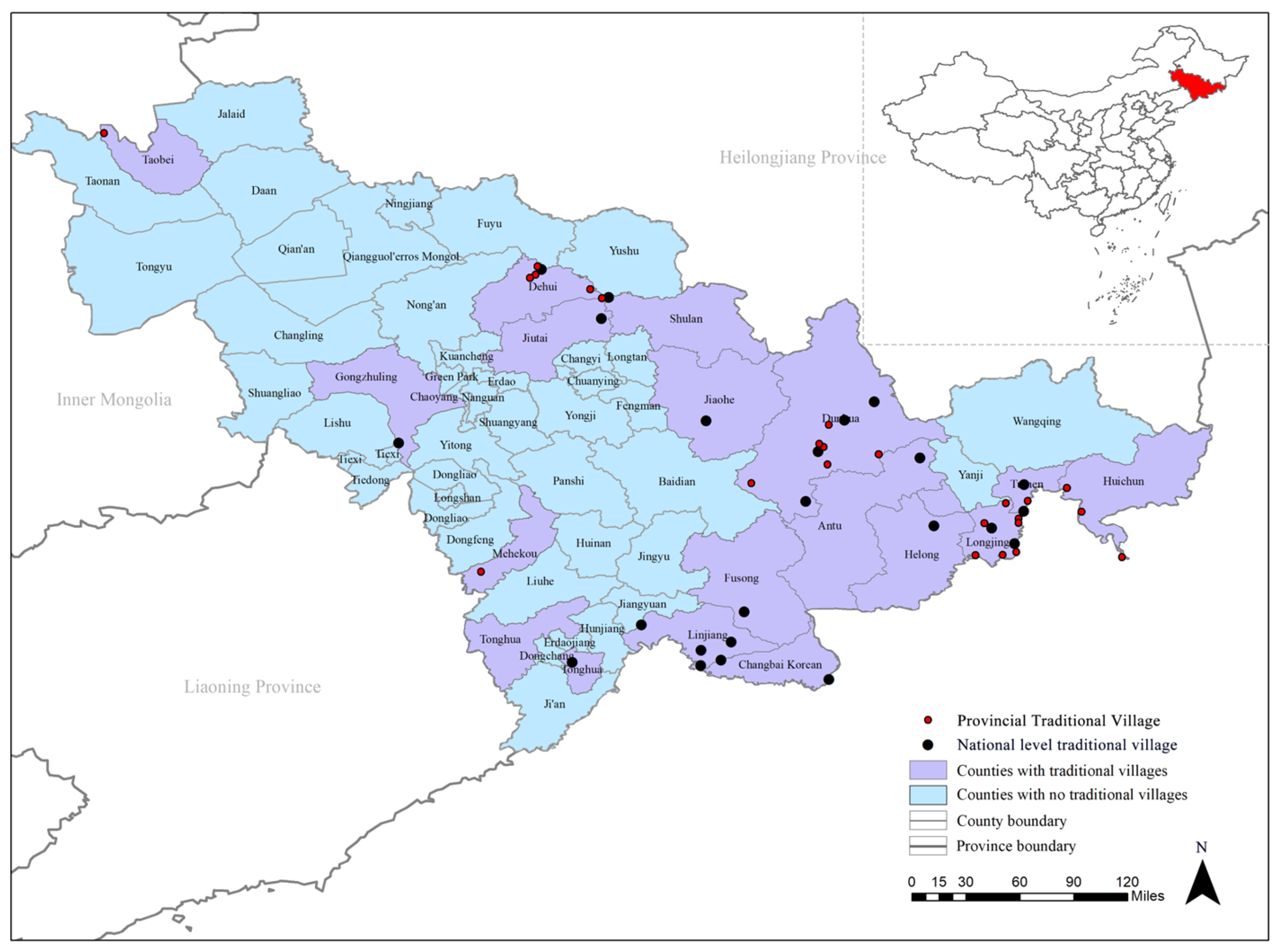
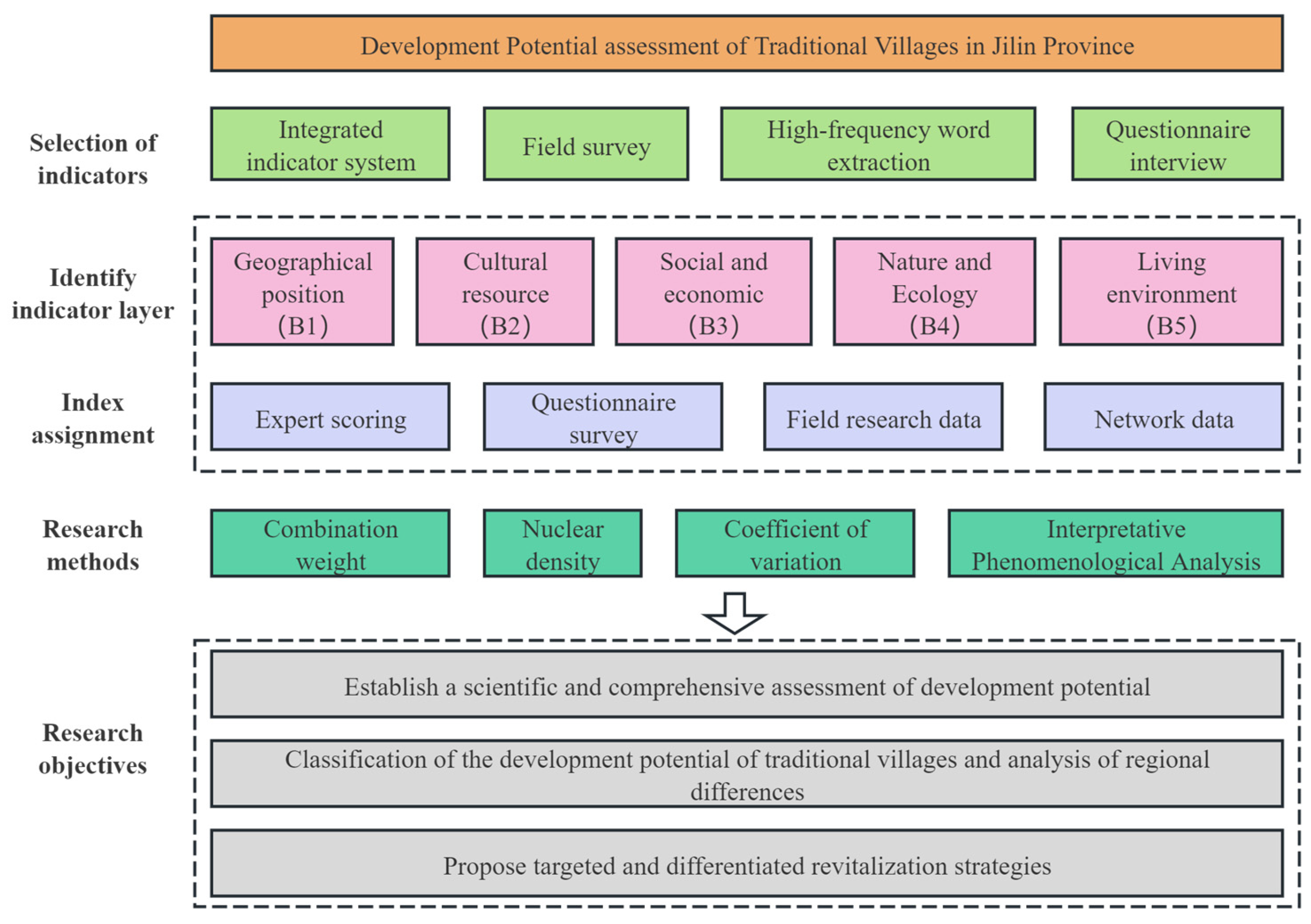
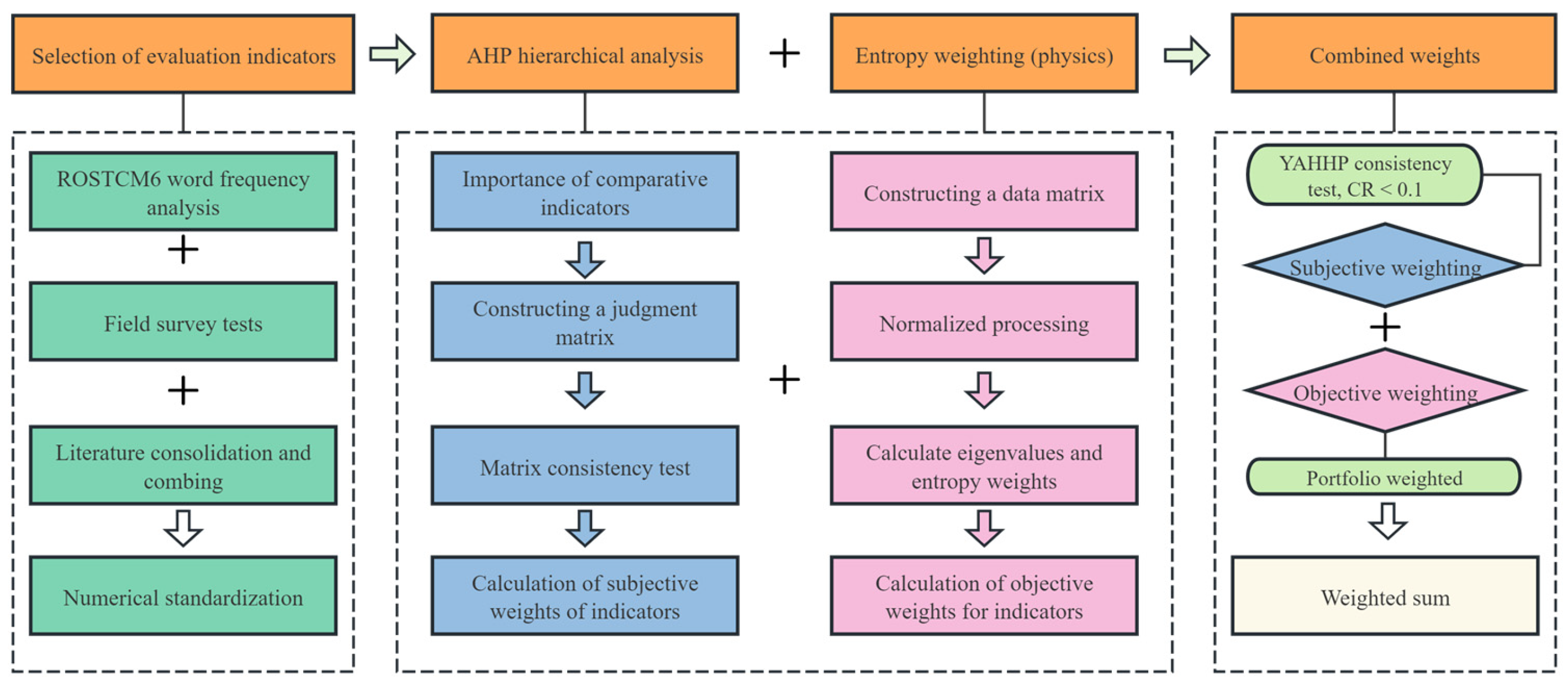
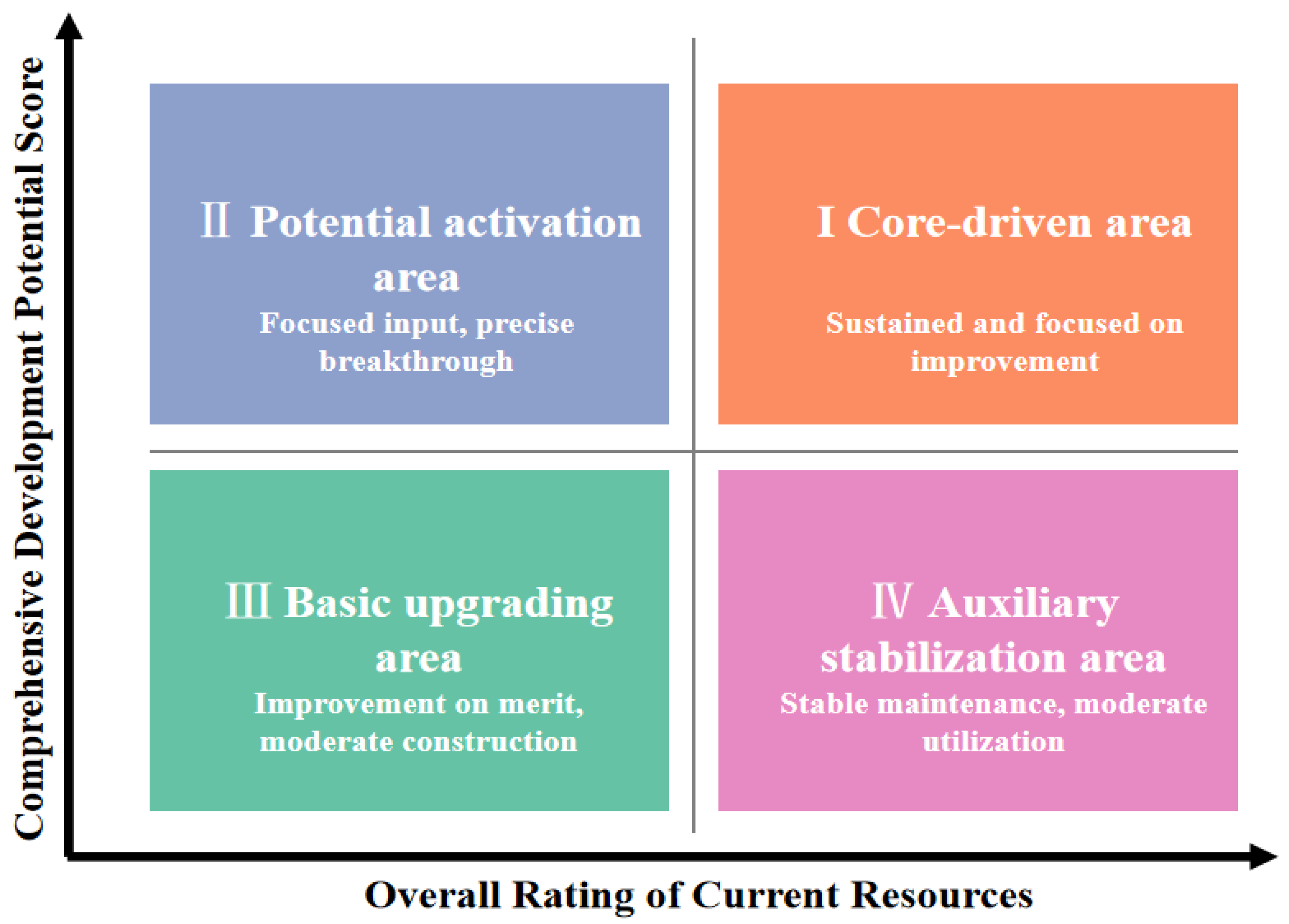
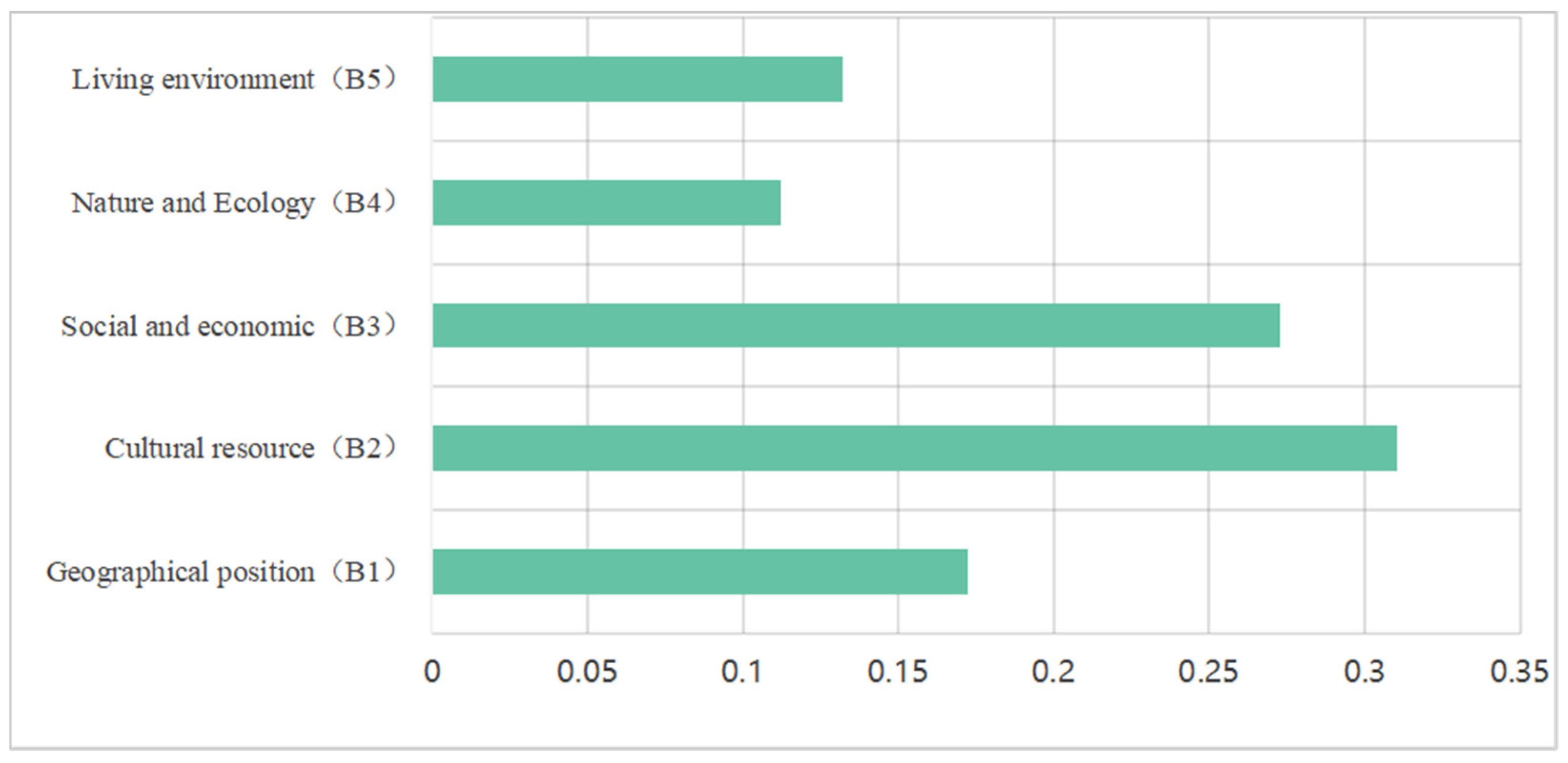
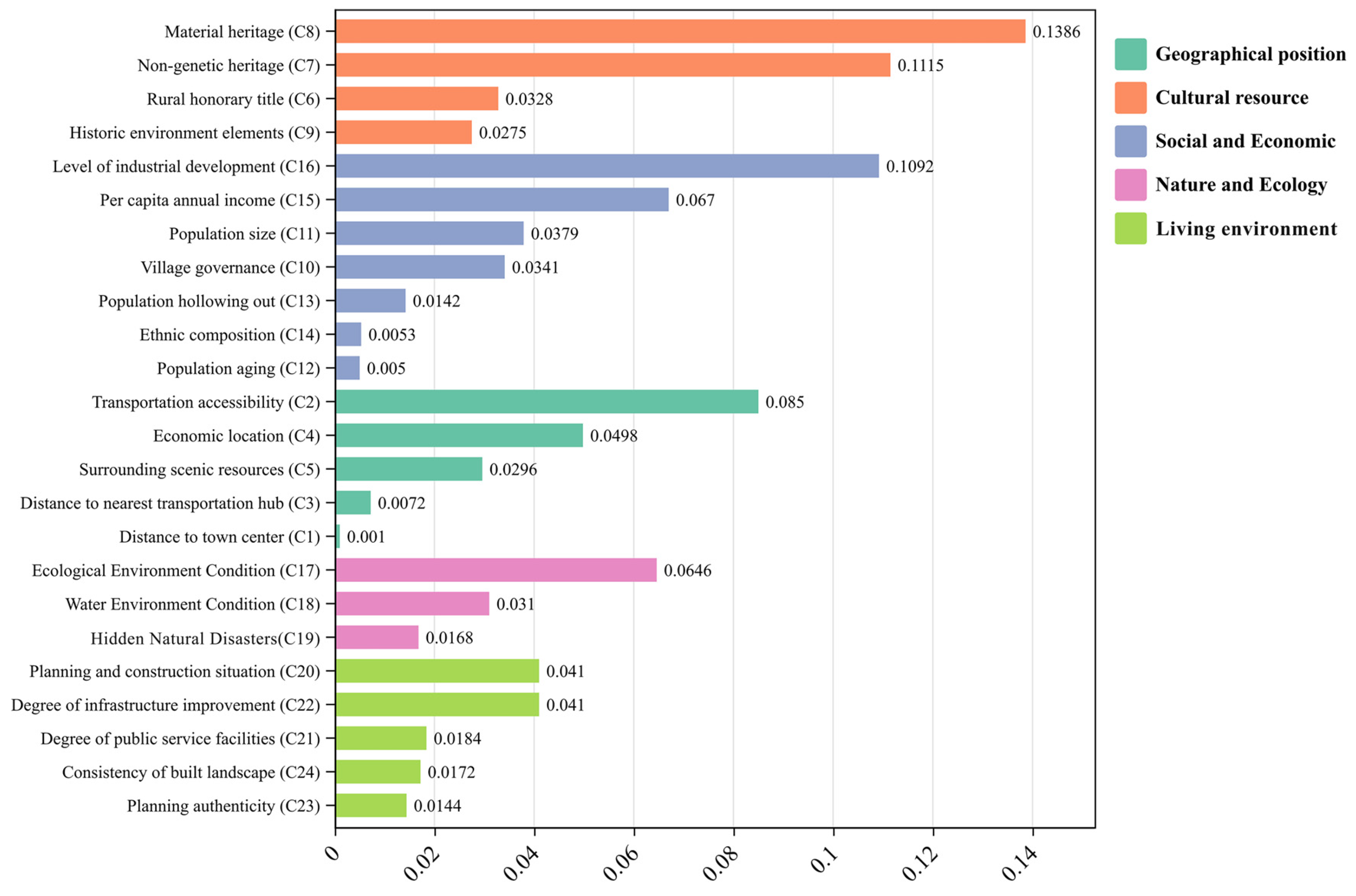

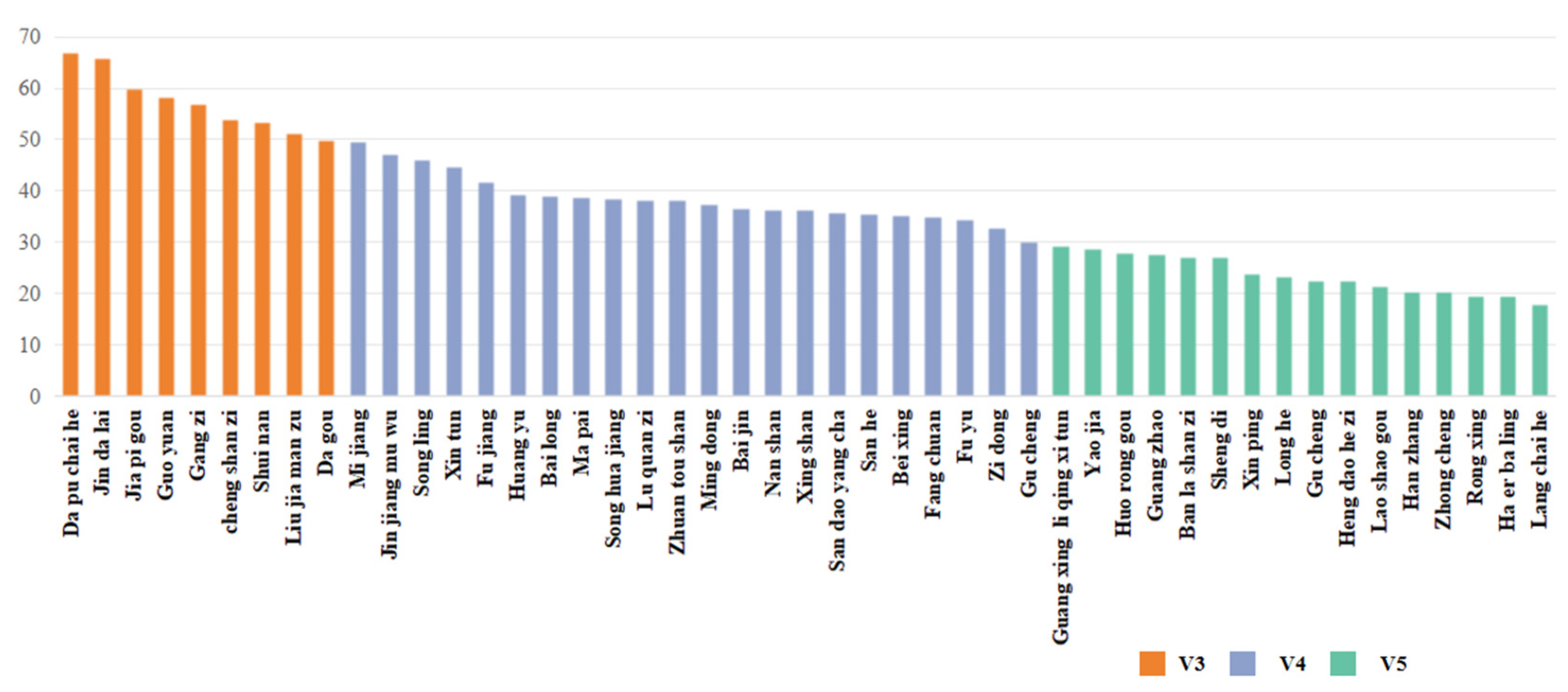
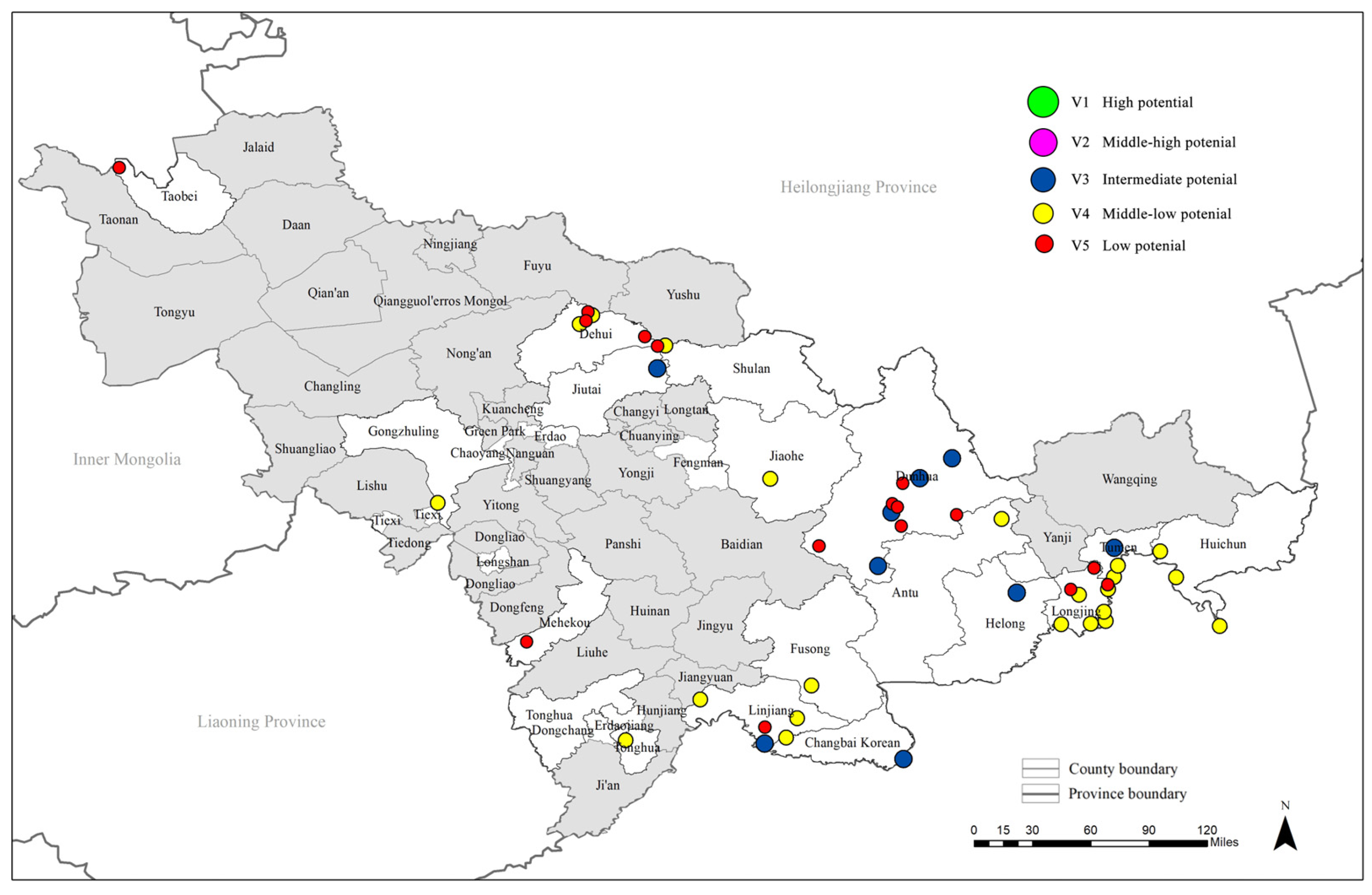
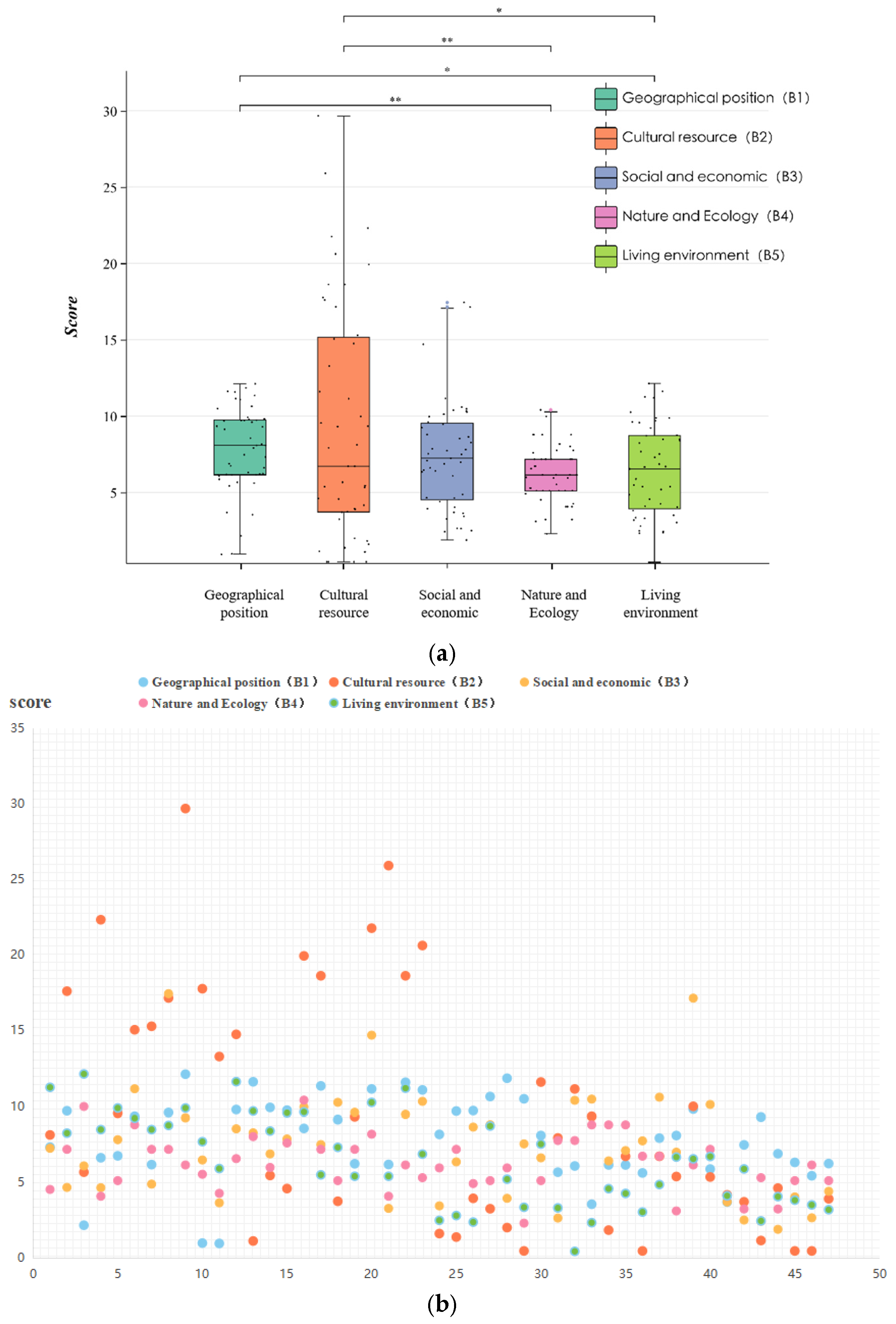
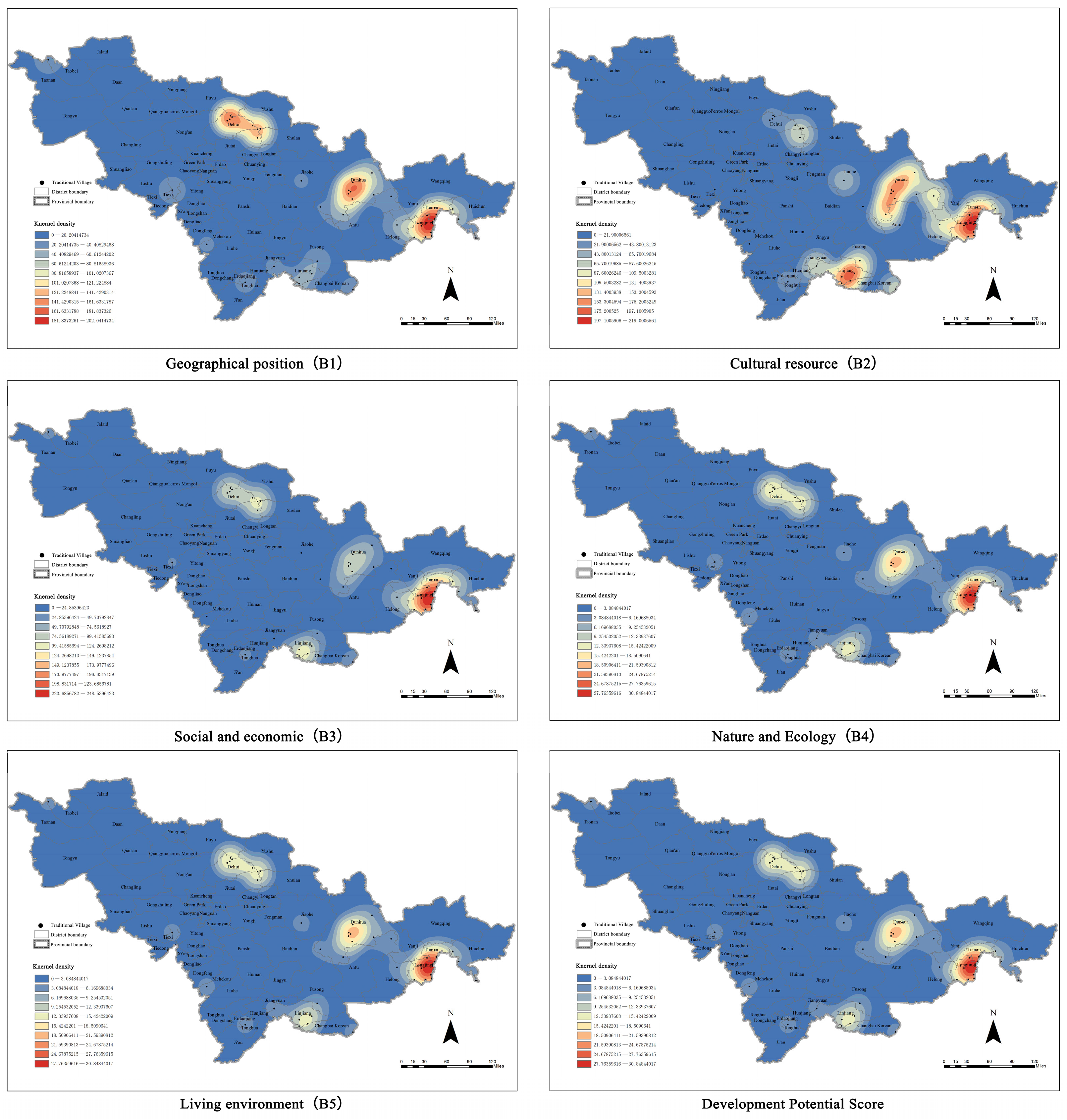
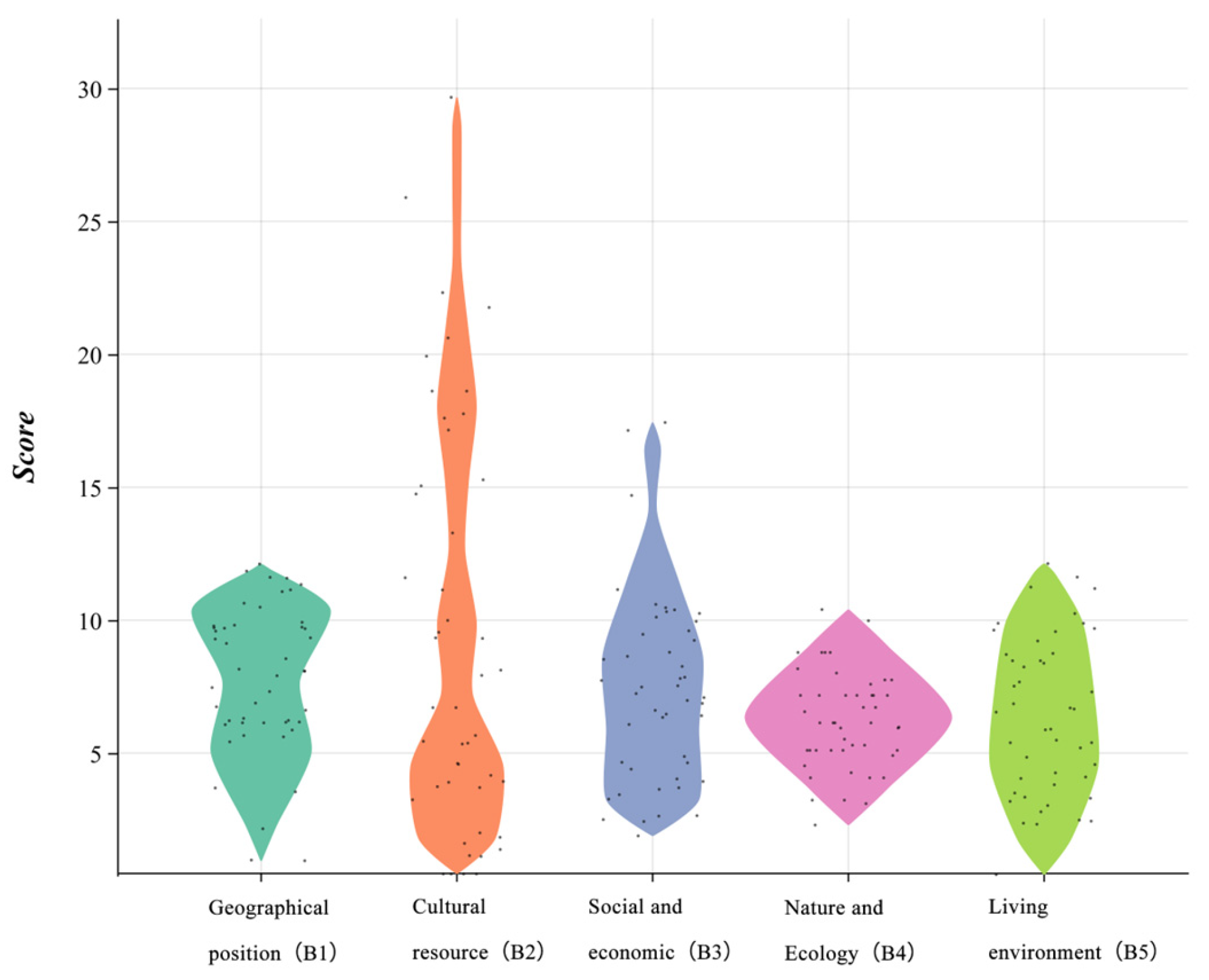
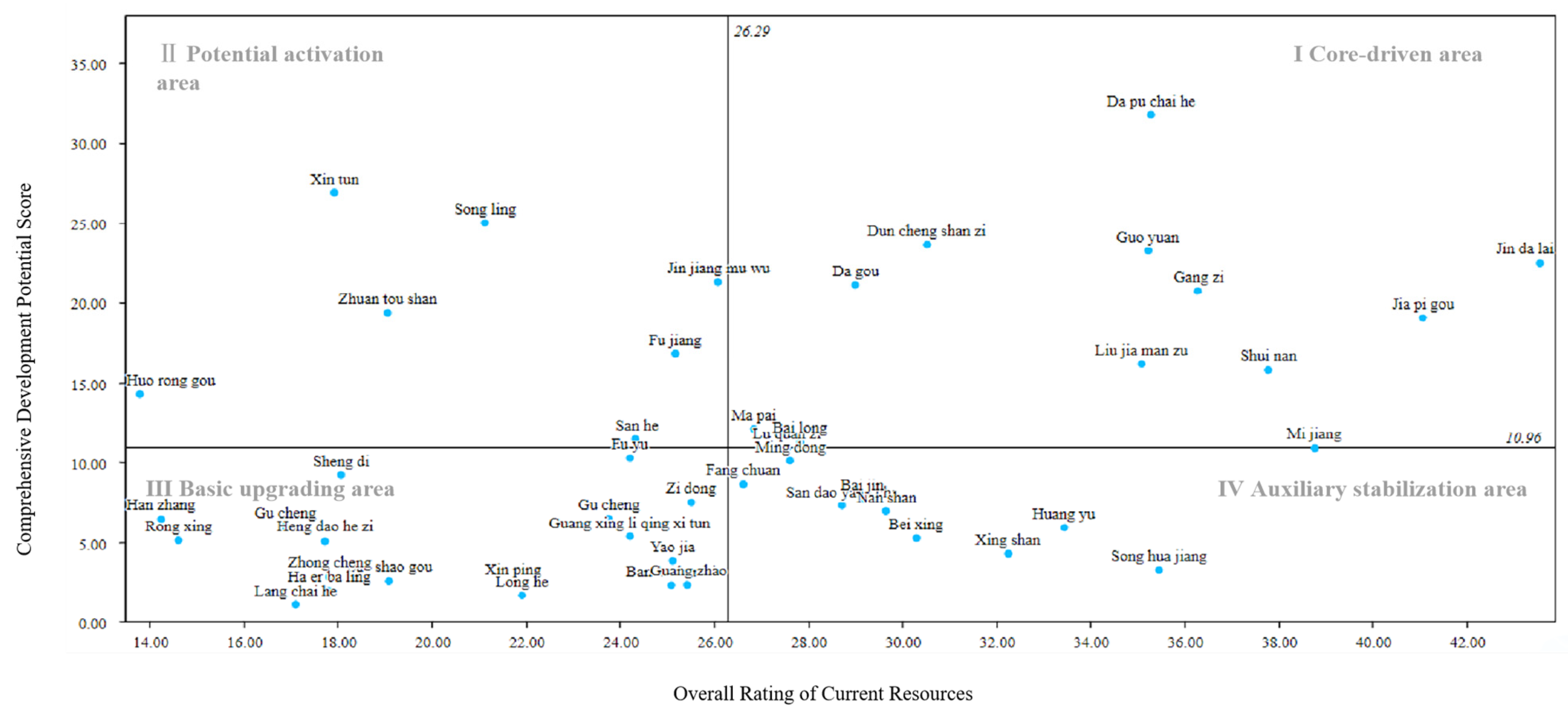
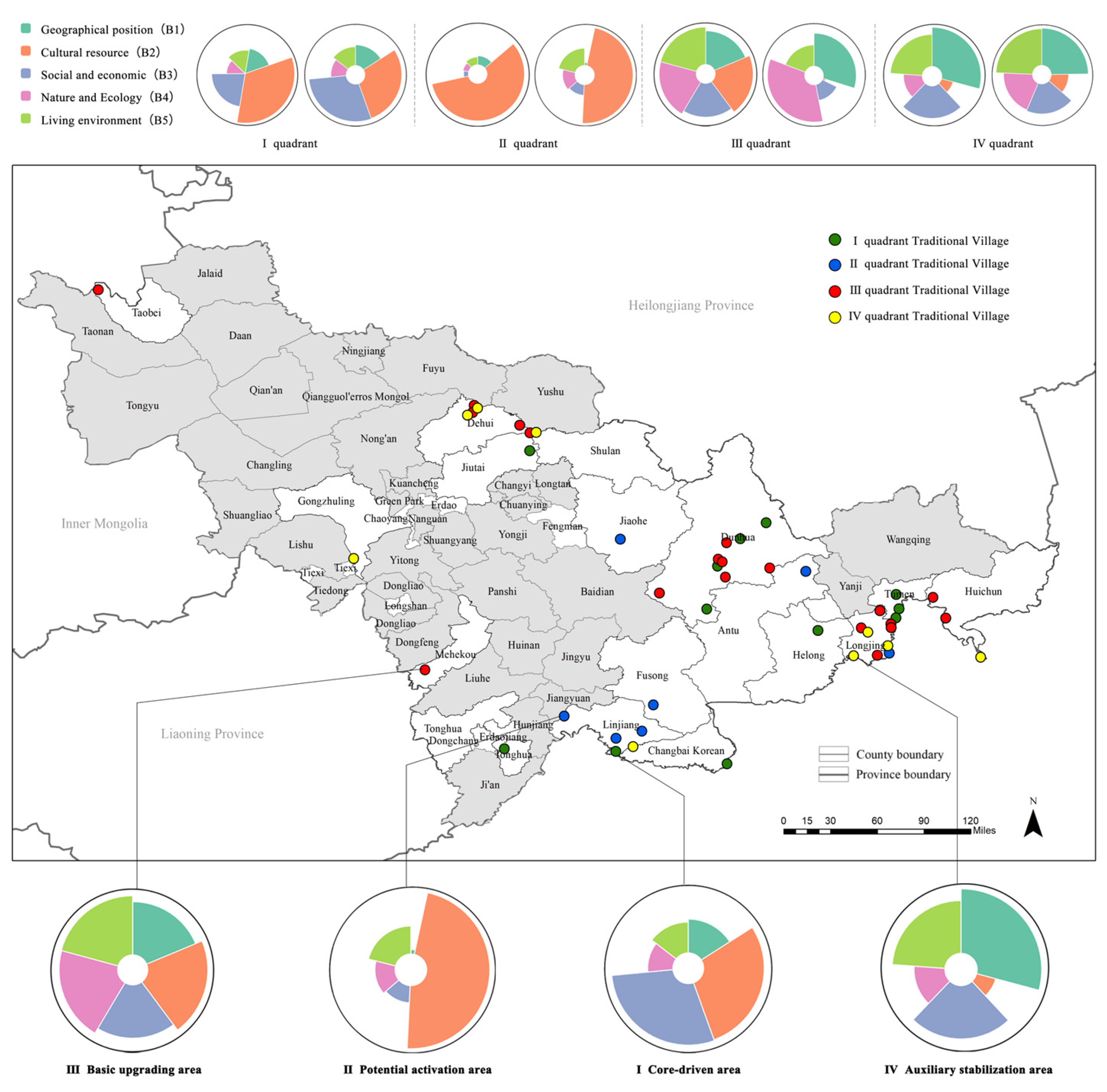
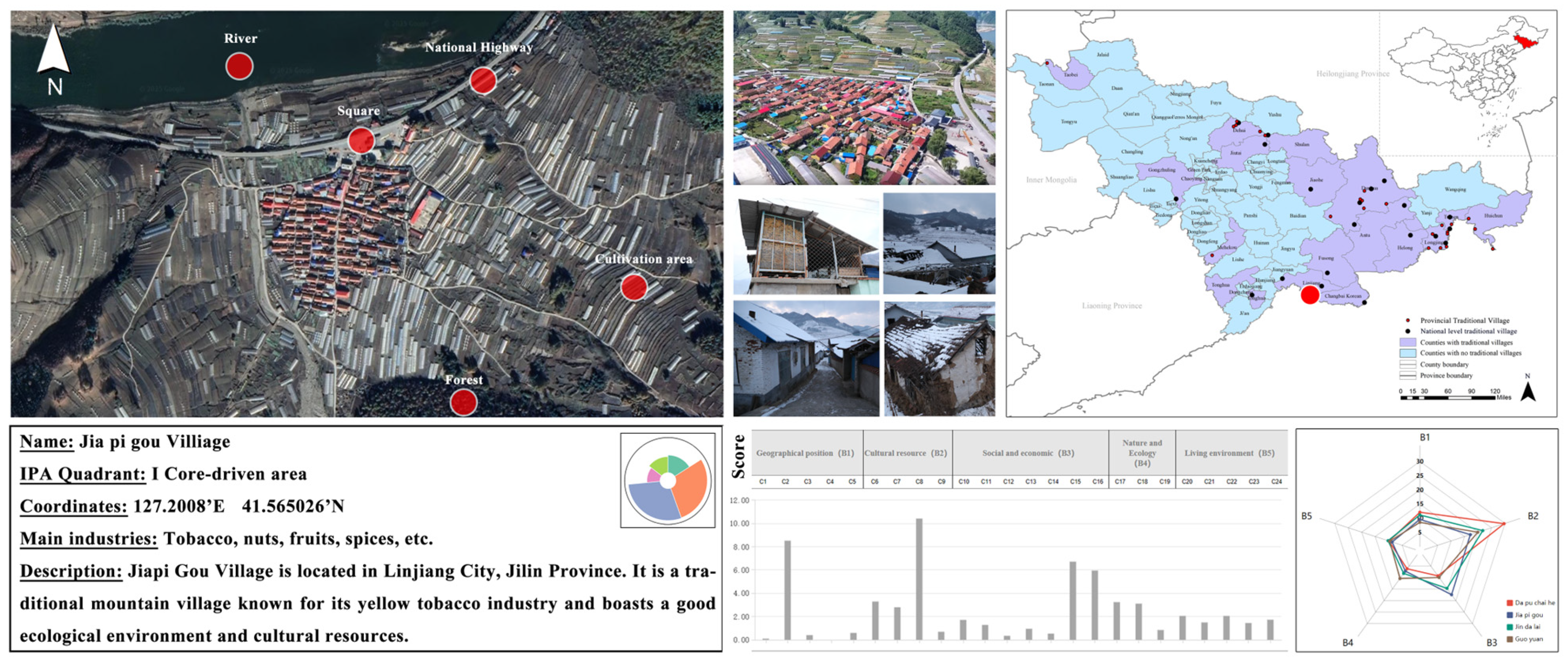
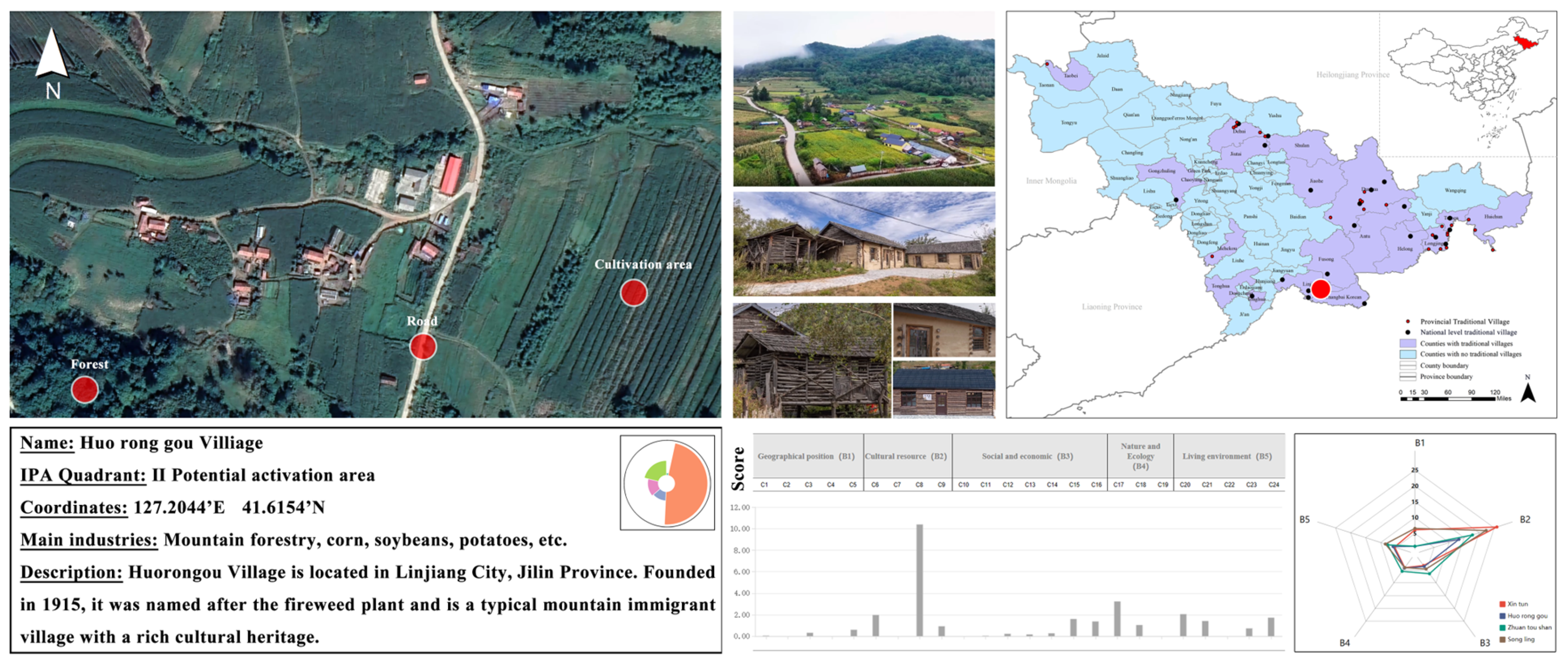
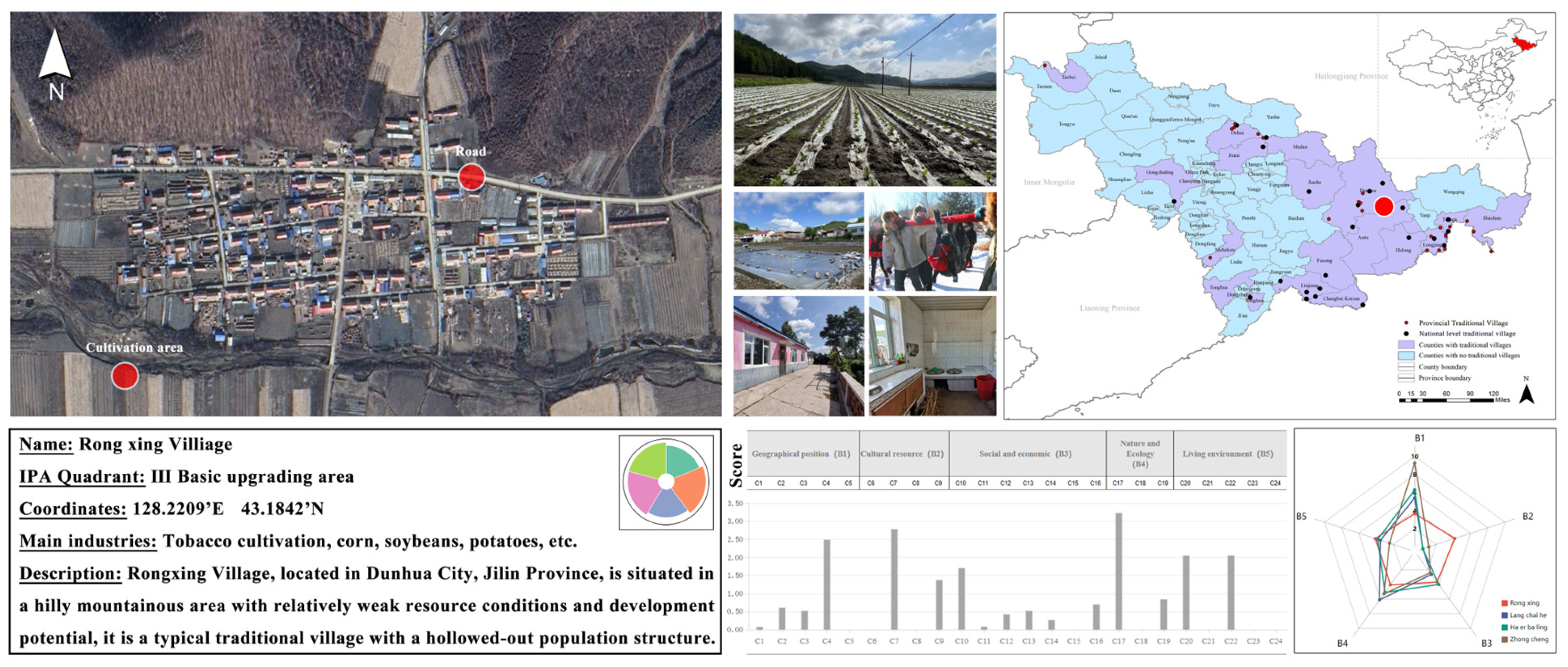
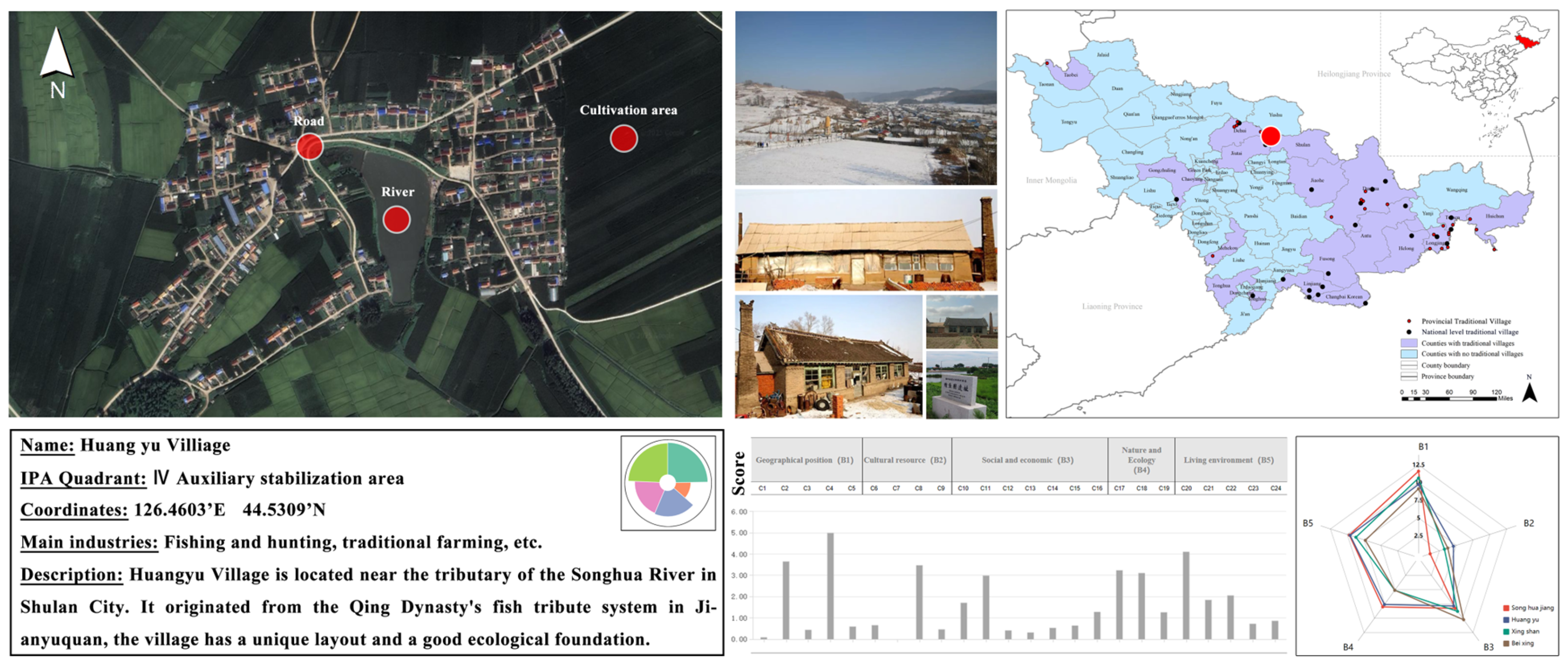
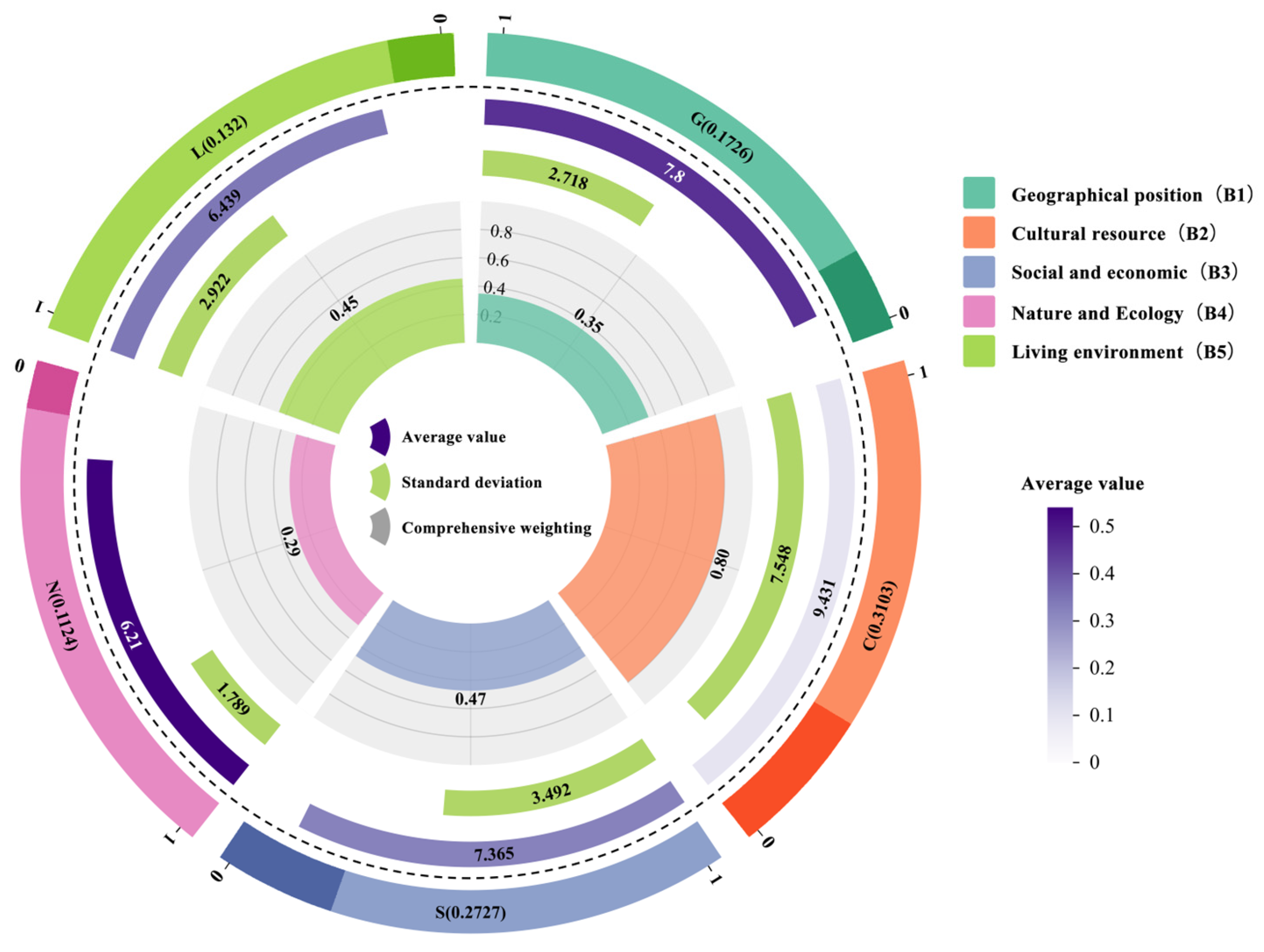
| Target Layer A | Guideline Layer B | Evaluation Layer C | Interpretation |
|---|---|---|---|
| Development Potential Assessment of Traditional Villages in Jilin Province (A) | Geographical Position (B1) | Distance from urban center (C1) | The developmental interdependence and spatial location relationship between villages and town centers |
| Transportation accessibility (C2) | The grade and quantity of transportation infrastructure, and its accessibility throughout the four seasons | ||
| Distance from nearest transportation hub (C3) | The spatial distance from the village to the nearest highway, railway, station, and other transportation nodes | ||
| Economic location (C4) | The level of economic development in the county where the village is located | ||
| Surrounding scenic resources (C5) | The distribution and grade of tourist attractions in the surrounding areas of the village | ||
| Cultural Resource (B2) | Rural honorary titles (C6) | Honorary titles awarded to the village by various levels of government and organizations | |
| Intangible cultural heritage transmission (C7) | The number and activity level of intangible cultural heritage projects, and the extent to which residents continue traditional customs | ||
| Tangible cultural heritage (C8) | The number of immovable and movable cultural heritage sites, the overall design, structural features, decorative details, and scale of existing traditional buildings (groups) | ||
| Historical environmental elements (ancient trees, wells, ancient bridges, etc.) (C9) | Historical environmental elements listed in the National Register of Traditional Villages, current preserved historical ecological elements, and restoration/repair projects | ||
| Social and Economic (B3) | Village-level governance (C10) | The extent of public participation in rural governance and development | |
| Population size (C11) | Rural permanent resident population density standards | ||
| Population aging (C12) | The proportion of elderly residents in the village’s permanent population | ||
| Population hollowing out (C13) | The gap between the permanent resident population and the registered household population of the village | ||
| Ethnic composition (C14) | Whether the village is a single-ethnicity settlement, a multi-ethnic mixed settlement, and whether it possesses cultural purity | ||
| Per capita annual income (C15) | The per capita yearly income of village residents | ||
| Level of industrial development (C16) | The degree of modernization and efficiency of agriculture, and the annual income of the village collective | ||
| Nature and Ecology (B4) | Ecological environment status (C17) | Vegetation coverage rate, terrain undulation degree, and soil fertility degree | |
| Water environment status (C18) | The association between site selection and river water bodies | ||
| Natural disaster risks (C19) | Frequency and severity of natural disasters such as floods, waterlogging, typhoons, and geological hazards | ||
| Living Environment (B5) | Planning and construction status (C20) | Internal road network density, village core density, and per capita green space area in squares | |
| Public service facility coverage (C21) | The status of facilities such as education, elderly care, healthcare, sports, and commerce | ||
| Infrastructure completeness (C22) | The status of productive and living infrastructure | ||
| Planning authenticity (C23) | The extent to which the village’s location and layout restore traditional lifestyles and the comprehensive value they reflect | ||
| Consistency of built landscape (C24) | The village’s texture, street scale, spatial layout, and architectural style reflect the imprint of the times |
| Guideline Layer B | Average () | Standard Deviation () | Coefficient of Variation () |
|---|---|---|---|
| Geographical position (B1) | 7.800 | 2.718 | 0.349 |
| Cultural resource (B2) | 9.431 | 7.548 | 0.800 |
| Social and economic (B3) | 7.365 | 3.492 | 0.474 |
| Nature and ecology (B4) | 6.210 | 1.789 | 0.288 |
| Living environment (B5) | 6.439 | 2.922 | 0.454 |
| Quadrant | Area | Quantity/Proportion | Characteristics | Typical Villages |
|---|---|---|---|---|
| I | Core-driven area | 12/25.53% | They perform well in terms of existing resources (such as geographical position, cultural resources, ecological environment, etc.) and development potential (such as cultural tourism, intangible cultural heritage inheritance, etc.), and have strong potential for sustainable development. They occupy a dominant position among traditional villages in Jilin Province and are suitable for further improvement in resource integration and utilization. | Dapu Chaihe Village, Jindale Village, Jiapi Gou Village |
| II | Potential activation area | 7/14.89% | They have a strong foundation in terms of resources, but their actual performance has not fully realized their potential, and their development is lagging behind. The reasons for their underperformance may be related to imperfect infrastructure construction and insufficient development of cultural resources. | Huorong Gou Village, Xintun Village |
| III | Basic upgrading area | 19/40.43% | They are relatively weak in terms of existing resources and development potential and are lagging behind in development. Resource scarcity and inadequate infrastructure have created significant bottlenecks in their development. | Langchaihe Village, Rongxing Village |
| IV | Auxiliary stabilization area | 9/19.15% | They are relatively weak in terms of existing resources, but have great development potential, especially in terms of cultural heritage protection, intangible cultural heritage inheritance, and tourism development, where there is significant room for improvement. | Songhua Jiang Village, Huangyu Village, Xingshan Village |
Disclaimer/Publisher’s Note: The statements, opinions and data contained in all publications are solely those of the individual author(s) and contributor(s) and not of MDPI and/or the editor(s). MDPI and/or the editor(s) disclaim responsibility for any injury to people or property resulting from any ideas, methods, instructions or products referred to in the content. |
© 2025 by the authors. Licensee MDPI, Basel, Switzerland. This article is an open access article distributed under the terms and conditions of the Creative Commons Attribution (CC BY) license (https://creativecommons.org/licenses/by/4.0/).
Share and Cite
Wang, C.; Zhang, G.; Zhai, Y. Integrating AHP-Entropy and IPA Models for Strategic Rural Revitalization: A Case Study of Traditional Villages in Northeast China. Buildings 2025, 15, 2475. https://doi.org/10.3390/buildings15142475
Wang C, Zhang G, Zhai Y. Integrating AHP-Entropy and IPA Models for Strategic Rural Revitalization: A Case Study of Traditional Villages in Northeast China. Buildings. 2025; 15(14):2475. https://doi.org/10.3390/buildings15142475
Chicago/Turabian StyleWang, Chenghao, Guangping Zhang, and Yunying Zhai. 2025. "Integrating AHP-Entropy and IPA Models for Strategic Rural Revitalization: A Case Study of Traditional Villages in Northeast China" Buildings 15, no. 14: 2475. https://doi.org/10.3390/buildings15142475
APA StyleWang, C., Zhang, G., & Zhai, Y. (2025). Integrating AHP-Entropy and IPA Models for Strategic Rural Revitalization: A Case Study of Traditional Villages in Northeast China. Buildings, 15(14), 2475. https://doi.org/10.3390/buildings15142475





